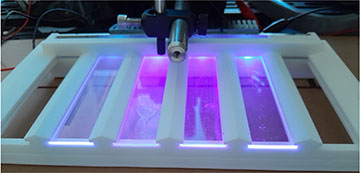
Because the glass has a silica nanoparticle coating, the UV waves bounce through the glass interior which enables an evenly “glowing” glass surface. [Image: Lanzarini-Lopes research group]
Biofilm—an assemblage of microorganisms attached to each other and usually to a surface—grows incredibly quickly on glass and other materials submerged in water. Accumulation of biofilm can damage oceanographic equipment and decrease the optical transparency of windows used for cameras and communication devices.
Now, researchers in the United States have developed a UV-emitting glass that they say can reduce 98% of visible biofilm growth (Biofilm, doi: 10.1016/j.bioflm.2024.100186). The technology, based on the use of nanoparticle-enabled waveguides, has the potential to enhance surface hygiene, mitigate microbial contamination and disinfect transparent surfaces.
Leveraging UV light
Current approaches for biofilm prevention include biocidal coatings, which use an active agent to kill organisms, and non-biocidal coatings. Biocidal coatings can affect other marine organisms and have negative consequences for ecosystems. Non-biocidal coatings must fulfill a long list of requirements, such as long-term mechanical and chemical stability, proper adherence to a surface and ease of application.
UV-C radiation, on the other hand, is chemical-free and prevents microorganism growth even at extremely low irradiance. Mariana Lanzarini-Lopes, whose laboratory at the University of Massachusetts Amherst engineers platforms that enhance light transport and reactions for photon-driven water treatment, thought about leveraging UV light as a way to prevent marine biofilm formation.
“We had previously discovered that light guides can scatter UV light with the help of surface modifications by nanoparticles,” said study author Lanzarini-Lopes. “Since windows and lenses are waveguides, we thought to do the same approach and allow germicidal light to prevent the growth of this biofilm.”

The glass treated with UV rays (inside), had 98% less biofilm growth than the untreated glass (outside). [Image: Lanzarini-Lopes research group]
Reduced biological growth
The study aimed to provide proof of concept that UV-emitting glass could inhibit biofilm growth. The researchers modified UV transparent quartz slides by applying 200 nm-diameter silica nanoparticles, selected because of their low absorptivity and high scattering coefficient at 265 nm. The slides were then coated with transparent optical polymer and dried. Testing revealed that the glass maintained visible and IR transparency metrics of over 99%.
After a 20-day submersion in the waters of Port Canaveral, FL, USA, the UV-emitting glass reduced visible biological growth by 98% when compared with control polymer slides with no UV. The technology, which is under a provisional patent, can be used for windows, camera lenses and sensors for oceanographical, agricultural and water-treatment applications.
“We are working on optimizing the process, reducing the energy consumption associated with this technology and continuing to develop the tech to be more modular to other surfaces such as ship hulls,” said Lanzarini-Lopes.
